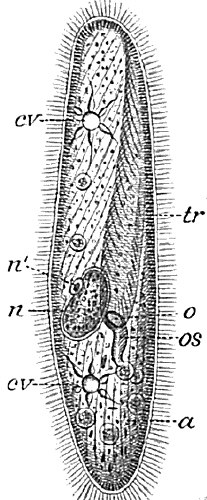








We often think of unicellular organisms as having simple, primitive structure. This is definitely an erroneous view when applied to the ciliates; they are probably the most complex of all unicellular organisms. Unlike multicellular organisms, which have cells specialized for performing the various body functions, single-celled organisms must perform all these functions with a single cell, and so their structure may be much more complex than the cells of larger organisms. Movement, sensitivity to the environment, water balance, and food capture must all be accomplished with the machinery in a single cell.
Ciliates include some of the largest free-living unicellular organisms (the ciliate Stentor can reach 2 millimeters in length), and include a wide variety of forms. We will use Paramecium, depicted at left, as a more or less typical ciliate for demonstrating features of ciliate anatomy.
Unlike other eukaryotes, ciliates have two kinds of nuclei. The micronucleus (labeled n' on this diagram) contains chromosomes, with two copies of each chromosome; hence this nucleus is diploid, as is common in eukaryotes. A cillate may have one or several micronuclei. In the much larger macronucleus (n), the genetic material is in the form of short pieces of DNA, each of which may exist in tens of thousands of copies. At cell division, the micronuclei divide through mitosis, while in most ciliates the macronucleus simply pinches apart into two.
Aside from the nuclei, a ciliate contains several vacuoles, or round membranous structures that enclose food, waste, or various structures. Digestive vacuoles form at the end of the gullet (os) as food particles are ingested, and then circulate through the cell. Waste remaining in these vacuoles is discharged through a particular point in the cell membrane known as the cytoproct. The star-shaped contractile vacuole (cv) gathers excess water through microtubule-lined channels (the "rays" of the star) and periodically pumps it out through another special pore.
The outer layer, or cortex, is a complicated structure, separated from the interior of the cell by a layer of microfilaments. Each hair-like cilium is associated with a set of tubules and structural protein molecules that make up a kinetosome. In turn, kinetosomes are arranged in rows known as kineties. The cilia beat in waves to propel the organism forward and also move food into the cytostome, the ciliate's "mouth," labelled (o). The mouth is sometimes set back in an oral groove (tr). The kineties around the cytostome are often arranged in a specialized way to generate water currents that funnel food particles into the cell. Also part of the cortex are the extrusomes, organelles that can rapidly eject short threadlike structures. These extrusomes function in predation, defense, and in forming cysts in various ciliates.


